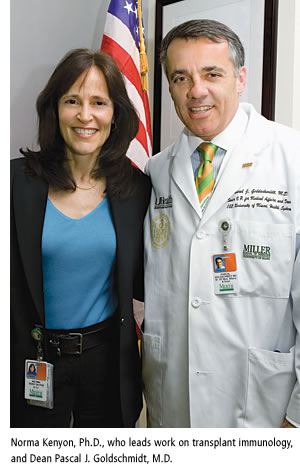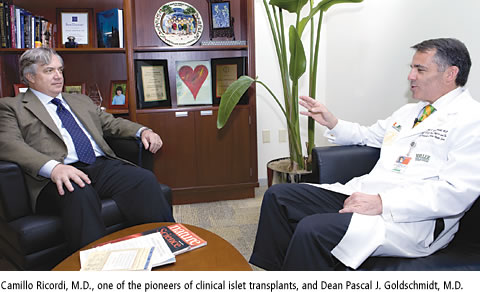 There’s nothing like a healthy newborn baby to make people merry—at least that is what we all expect as we grow our families. But what if …? In the case of Norma Kenyon, Ph.D., the “if” came with the news that her young baby daughter was seriously ill because of insulin-dependent diabetes mellitus—or type 1 diabetes in our medical jargon. The world flips upside down when we hear that our child is sick. Not to mention when it is a chronic illness that will affect his or her life in perpetuity—an illness for which there is no cure, only an imperfect treatment that, although lifesaving, does not restore health fully. There’s nothing like a healthy newborn baby to make people merry—at least that is what we all expect as we grow our families. But what if …? In the case of Norma Kenyon, Ph.D., the “if” came with the news that her young baby daughter was seriously ill because of insulin-dependent diabetes mellitus—or type 1 diabetes in our medical jargon. The world flips upside down when we hear that our child is sick. Not to mention when it is a chronic illness that will affect his or her life in perpetuity—an illness for which there is no cure, only an imperfect treatment that, although lifesaving, does not restore health fully.
That reality hit home for Norma on the night many years ago when she got the call that her daughter was in the hospital. Her first thoughts? Meningitis, maybe pneumonia. But her 14-month-old daughter had fallen into a coma with the onset of type 1 diabetes.
After the crisis, in the phase of her daughter’s illness that doctors call the “honeymoon,” Norma would inject her daughter with one and a half units of insulin a day. As an immunologist she says she felt “torture” because “you know there are beta cells and they are just slowly going away.”
Norma Kenyon was desperately aware that something more needed to be done. Not only for her beloved baby, but also for the tens of millions of children, adolescents, and even adults who suffer from diabetes. She’s a scientist. Scientists discover cures. Her career has zeroed in on finding a cure for diabetes, and she is close to that goal.
In their quest for a cure, Norma and her team have concentrated their work in the area of transplant immunology. They have focused on ways to transplant islet cells without the need for antirejection drugs, so that the patient’s body will tolerate the insulin-producing cells.

Norma’s career path was heavily influenced by her own daughter. We often don’t know who or what will be the driving force behind the careers we choose. And when we choose medicine, we often don’t know where it will lead us.
Far away from Norma’s home was a young doctor whose life had oscillated for a while between musical arts and medicine. While still in his home country of Italy, Camillo Ricordi, M.D., decided to become a transplant surgeon. It was a gigantic step and a complete departure from the traditions of a family famous for founding Casa Ricordi, the music publishing house with Puccini and Verdi in its repertoire. Camillo left his home to find his dream in America. In his case, his home was not simply any home—it was Teatro alla Scala, the world-famous opera house in Milan. That’s a tough home to leave to pursue a young surgeon’s quest.
But he was determined, and he landed in Pittsburgh where he worked with giants of transplant sciences, such as Thomas Starzl, M.D., Ph.D., and, closer to our home, Andreas Tzakis, M.D., Ph.D. Then one day he was recruited to lead the Diabetes Research Institute (DRI) at the University of Miami, a place he adopted as the future of his career.
Camillo is now one of the world’s leading scientists in cell transplantation. He is renowned for inventing the “Ricordi chamber,” the device that made it possible to isolate large numbers of insulin-producing islet cells from a donor pancreas. It was Camillo who performed the first series of clinical islet transplants in patients with diabetes. Many of these patients were able to come off insulin completely or greatly reduce their need for the medication.
With Camillo’s arrival at the University of Miami, a great new hope was born to find a cure for this dreadful disease. The strategic plan to combat diabetes is simple but on target: Transplanted insulin-producing cells will replace the beta islet cells that have succumbed to the injury of type 1 diabetes—and under appropriate conditions will survive, escape the attack of the immune system, register information relative to glycemia, and organize a successful response based on insulin production.
With Norma Kenyon, Camillo Ricordi, and the entire team of the Diabetes Research Institute—supported by Bob Pearlman and the Diabetes Research Institute Foundation, itself supported by so many parents of children who have been affected with type 1 diabetes—we know that the DRI will finally develop a cure for this formidable illness.
We can now sense that a cure is near. Year after year with extraordinary discoveries and step-by-step refinement of the strategy, we have seen it coming: the ultimate treatment that will transform type 1 diabetes into nothing more than a transient illness and a bad memory. We are confident because the Miller School is committed to this, and we have the very best researchers—scientists like Norma and Camillo, who are simply passionate about winning this war. They want to win to prevent people like Norma’s precious daughter—who is 16 now and doing well—from ever having to experience the grave illness that diabetes brings.
As the dean of the Miller School of Medicine at the University of Miami, it gives me great pride to share with readers the interviews I conducted with Norma Kenyon, professor of surgery, medicine, microbiology and immunology, and biomedical engineering; holder of the Martin Kleiman Endowed Chair in Diabetes Research; director of the Wallace H. Coulter Center for Translational Research; and co-director of the Executive Research Council at the Diabetes Research Institute; and with Camillo Ricordi, Distinguished Professor of Medicine and professor of surgery, biomedical engineering, and microbiology and immunology; chief of the Division of Cellular Transplantation in the Department of Surgery; and the Stacy Joy Goodman Chair in Diabetes Research. Camillo is also the scientific director and chief academic officer of the Diabetes Research Institute.
Norma and Camillo spoke candidly about the amazing journey that will steadfastly lead them to find a cure for diabetes. To read the full transcripts of the interviews, go to med.miami.edu/deansoffice/dean's_perspective.asp.
|


